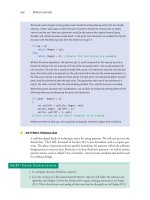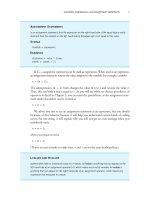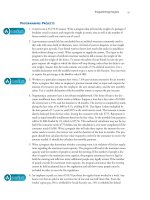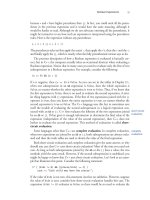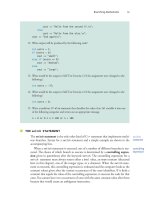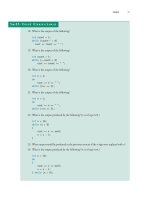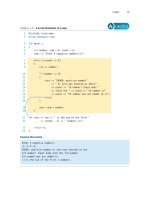Absolute C++ (4th Edition) part 6 doc
Bạn đang xem bản rút gọn của tài liệu. Xem và tải ngay bản đầy đủ của tài liệu tại đây (138 KB, 10 trang )
Boolean Expressions 51
because > and < have higher precedence than ||. In fact, you could omit all the paren-
theses in the previous expression and it would have the same meaning, although it
would be harder to read. Although we do not advocate omitting all the parentheses, it
might be instructive to see how such an expression is interpreted using the precedence
rules. Here is the expression without any parentheses:
x + 1 > 2 || x + 1 < -3
The precedences rules say first apply the unary -, then apply the +’s, then the > and the <,
and finally apply the
||, which is exactly what the fully parenthesized version says to do.
The previous description of how a Boolean expression is evaluated is basically cor-
rect, but in C++, the computer actually takes an occasional shortcut when evaluating a
Boolean expression. Notice that in many cases you need to evaluate only the first of two
subexpressions in a Boolean expression. For example, consider the following:
(x >= 0) && (y > 1)
If x is negative, then (x >= 0) is false. As you can see in the tables in Display 2.1,
when one subexpression in an
&& expression is false, then the whole expression is
false, no matter whether the other expression is true or false. Thus, if we know that
the first expression is
false, there is no need to evaluate the second expression. A simi-
lar thing happens with
|| expressions. If the first of two expressions joined with the ||
operator is true, then you know the entire expression is true, no matter whether the
second expression is
true or false. The C++ language uses this fact to sometimes save
itself the trouble of evaluating the second subexpression in a logical expression con-
nected with an
&& or ||. C++ first evaluates the leftmost of the two expressions joined
by an
&& or ||. If that gives it enough information to determine the final value of the
expression (independent of the value of the second expression), then C++ does not
bother to evaluate the second expression. This method of evaluation is called short-
circuit evaluation.
Some languages other than C++ use complete evaluation. In complete evaluation,
when two expressions are joined by an
&& or ||, both subexpressions are always evalu-
ated and then the truth tables are used to obtain the value of the final expression.
Both short-circuit evaluation and complete evaluation give the same answer, so why
should you care that C++ uses short-circuit evaluation? Most of the time you need not
care. As long as both subexpressions joined by the
&& or the || have a value, the two
methods yield the same result. However, if the second subexpression is undefined, you
might be happy to know that C++ uses short-circuit evaluation. Let’s look at an exam-
ple that illustrates this point. Consider the following statement:
if ( (kids != 0) && ((pieces/kids) >= 2) )
cout << "Each child may have two pieces!";
If the value of kids is not zero, this statement involves no subtleties. However, suppose
the value of
kids is zero; consider how short-circuit evaluation handles this case. The
expression
(kids != 0) evaluates to false, so there would be no need to evaluate the
short-circuit
evaluation
complete
evaluation
52 Flow of Control
Pitfall
second expression. Using short-circuit evaluation, C++ says that the entire expression is
false, without bothering to evaluate the second expression. This prevents a run-time
error, since evaluating the second expression would involve dividing by zero.
I
NTEGER
V
ALUES
C
AN
B
E
U
SED
AS
B
OOLEAN
V
ALUES
C++ sometimes uses integers as if they were Boolean values and bool values as if they were inte-
gers. In particular, C++ converts the integer
1 to true and converts the integer 0 to false, and
vice versa. The situation is even a bit more complicated than simply using
1 for true and 0 for
false. The compiler will treat any nonzero number as if it were the value true and will treat 0 as
if it were the value
false. As long as you make no mistakes in writing Boolean expressions, this
conversion causes no problems. However, when you are debugging, it might help to know that
the compiler is happy to combine integers using the Boolean operators
&&, ||, and !.
For example, suppose you want a Boolean expression that is
true provided that time has not yet
run out (in some game or process). You might use the following:
!time > limit
This sounds right if you read it out loud: “not time greater than limit.” The Boolean expression
is wrong, however, and unfortunately, the compiler will not give you an error message. The com-
piler will apply the precedence rules from Display 2.3 and interpret your Boolean expression as
the following:
(!time) > limit
This looks like nonsense, and intuitively it is nonsense. If the value of time is, for example, 36,
what could possibly be the meaning of
(!time)? After all, that is equivalent to “not 36.” But in
C++, any nonzero integer converts to
true and 0 is converted to false. Thus, !36 is interpreted
as “not
true” and so it evaluates to
false
,
which is in turn converted back to 0 because we are
comparing to an
int.
What we want as the value of this Boolean expression and what C++ gives us are not the same. If
time has a value of 36 and limit has a value of 60, you want the above displayed Boolean
expression to evaluate to
true (because it is not true that time > limit). Unfortunately, the
Boolean expression instead evaluates as follows:
(!time) evaluates to false
,
which is con-
verted to
0, so the entire Boolean expression is equivalent to
0 > limit
That in turn is equivalent to 0 > 60, because 60 is the value of limit, and that evaluates to
false
.
Thus, the above logical expression evaluates to false, when you want it to evaluate to
true.
There are two ways to correct this problem. One way is to use the
! operator correctly. When using
the operator
!, be sure to include parentheses around the argument. The correct way to write the
above Boolean expression is
integers
convert to
bool
Boolean Expressions 53
Self-Test Exercises
!(time > limit)
Another way to correct this problem is to completely avoid using the ! operator. For example, the
following is also correct and easier to read:
if (time <= limit)
You can almost always avoid using the ! operator, and some programmers advocate avoiding it
as much as possible.
1. Determine the value, true or false, of each of the following Boolean expressions, assuming
that the value of the variable
count is 0 and the value of the variable limit is 10. Give your
answer as one of the values
true or false.
a.
(count == 0) && (limit < 20)
b. count == 0 && limit < 20
c. (limit > 20) || (count < 5)
d. !(count == 12)
e. (count == 1) && (x < y)
f. (count < 10) || (x < y)
g. !( ((count < 10) || (x < y)) && (count >= 0) )
h. ((limit/count) > 7) || (limit < 20)
i. (limit < 20) || ((limit/count) > 7)
j. ((limit/count) > 7) && (limit < 0)
k. (limit < 0) && ((limit/count) > 7)
l. (5 && 7) + (!6)
2. You sometimes see numeric intervals given as
2 < x < 3
In C++ this interval does not have the meaning you may expect. Explain and give the
correct C++ Boolean expression that specifies that
x lies between 2 and 3.
3. Consider a quadratic expression, say
x
2
- x - 2
54 Flow of Control
Describing where this quadratic is positive (that is, greater than 0) involves describing a set
of numbers that are either less than the smaller root (which is –1) or greater than the larger
root (which is 2). Write a C++ Boolean expression that is true when this formula has
positive values.
4. Consider the quadratic expression
x
2
– 4x + 3
Describing where this quadratic is negative involves describing a set of numbers that are
simultaneously greater than the smaller root (1) and less than the larger root (3). Write a
C++ Boolean expression that is true when the value of this quadratic is negative.
Branching Mechanisms
When you come to a fork in the road, take it.
Attributed to Yogi Berra
■ if-else
STATEMENTS
An if-else statement chooses between two alternative statements based on the value
of a Boolean expression. For example, suppose you want to design a program to com-
pute a week’s salary for an hourly employee. Assume the firm pays an overtime rate of
one-and-one-half times the regular rate for all hours after the first 40 hours worked.
When the employee works 40 or more hours, the pay is then equal to
rate*40 + 1.5*rate*(hours - 40)
However, if the employee works less than 40 hours, the correct pay formula is simply
rate*hours
The following if-else statement computes the correct pay for an employee whether
the employee works less than 40 hours or works 40 or more hours,
if (hours > 40)
grossPay = rate*40 + 1.5*rate*(hours - 40);
else
grossPay = rate*hours;
The syntax for an if-else statement is given in the accompanying box. If the Bool-
ean expression in parentheses (after the
if) evaluates to true, then the statement before
the
else is executed. If the Boolean expression evaluates to false, the statement after
the
else is executed.
2.2
if-else
statement
Branching Mechanisms 55
if-else
S
TATEMENT
The if-else statement chooses between two alternative actions based on the value of a Boolean
expression. The syntax is shown below. Be sure to note that the Boolean expression must be
enclosed in parentheses.
S
YNTAX
: A S
INGLE
S
TATEMENT
FOR
E
ACH
A
LTERNATIVE
if (
Boolean_Expression
)
Yes_Statement
else
No_Statement
If the
Boolean_Expression
evaluates to true, then the
Yes_Statement
is executed. If the
Boolean_Expression
evaluates to false, then the
No_Statement
is executed.
S
YNTAX
: A S
EQUENCE
OF
S
TATEMENTS
FOR
E
ACH
A
LTERNATIVE
if (
Boolean_Expression
)
{
Yes_Statement_1
Yes_Statement_2
Yes_Statement_Last
}
else
{
No_Statement_1
No_Statement_2
No_Statement_Last
}
E
XAMPLE
if (myScore > yourScore)
{
cout << "I win!\n";
wager = wager + 100;
}
else
{
cout << "I wish these were golf scores.\n";
wager = 0;
}
56 Flow of Control
Notice that an if-else statement has smaller statements embedded in it. Most of
the statement forms in C++ allow you to make larger statements out of smaller state-
ments by combining the smaller statements in certain ways.
Remember that when you use a Boolean expression in an
if-else statement, the
Boolean expression must be enclosed in parentheses
.
■
COMPOUND STATEMENTS
You will often want the branches of an if-else statement to execute more than one
statement each. To accomplish this, enclose the statements for each branch between a
pair of braces,
{ and }, as indicated in the second syntax template in the box entitled
if-else Statement. A list of statements enclosed in a pair of braces is called a com-
pound statement. A compound statement is treated as a single statement by C++ and
may be used anywhere that a single statement may be used. (Thus, the second syntax
template in the box entitled
if-else Statement. is really just a special case of the first
one.)
There are two commonly used ways of indenting and placing braces in
if-else
statements, which are illustrated below:
if (myScore > yourScore)
{
cout << "I win!\n";
wager = wager + 100;
}
else
{
cout << "I wish these were golf scores.\n";
wager = 0;
}
and
if (myScore > yourScore){
cout << "I win!\n";
wager = wager + 100;
} else {
cout << "I wish these were golf scores.\n";
wager = 0;
}
The only differences are the placement of braces. We find the first form easier to read
and therefore prefer it. The second form saves lines, and so some programmers prefer
the second form or some minor variant of it.
parentheses
if-else
with multiple
statements
compound
statement
Branching Mechanisms 57
Self-Test Exercises
5. Does the following sequence produce division by zero?
j = -1;
if ((j > 0) && (1/(j+1) > 10))
cout << i << endl;
6. Write an if-else statement that outputs the word High if the value of the variable score
is greater than
100 and Low if the value of score is at most 100. The variable score is of
type
int.
U
SING
=
IN
P
LACE
OF
==
Unfortunately, you can write many things in C++ that you would think are incorrectly formed C++
statements but which turn out to have some obscure meaning. This means that if you mistakenly
write something that you would expect to produce an error message, you may find that the pro-
gram compiles and runs with no error messages but gives incorrect output. Since you may not
realize you wrote something incorrectly, this can cause serious problems. For example, consider
an
if-else statement that begins as follows:
if (x = 12)
Do_Something
else
Do_Something_Else
Suppose you wanted to test to see if the value of x is equal to 12, so that you really meant to use
== rather than =. You might think the compiler would catch your mistake. The expression
x = 12
is not something that is satisfied or not. It is an assignment statement, so surely the compiler will
give an error message. Unfortunately, that is not the case. In C++ the expression
x = 12 is an
expression that returns a value, just like
x + 12 or 2 + 3. An assignment expression’s value is
the value transferred to the variable on the left. For example, the value of
x = 12 is 12. We saw
in our discussion of Boolean value compatibility that nonzero
int values are converted to true.
If you use
x = 12 as the Boolean expression in an if-else statement, the Boolean expression
will always evaluate to
true.
This error is very hard to find, because it looks right. The compiler can find the error without any
special instructions if you put the 12 on the left side of the comparison: 12 == x will produce no
error message, but
12 = x will generate an error message.
Pitfall
58 Flow of Control
7. Suppose savings and expenses are variables of type double that have been given values.
Write an if-else statement that outputs the word Solvent, decreases the value of sav-
ings
by the value of expenses, and sets the value of expenses to zero provided that
savings is at least as large as expenses. If, however, savings is less than expenses, the
if-else statement simply outputs the word Bankrupt and does not change the value of
any variables.
8. Write an
if-else statement that outputs the word Passed provided the value of the vari-
able
exam is greater than or equal to 60 and also the value of the variable programsDone is
greater than or equal to
10. Otherwise, the if-else statement outputs the word Failed.
The variables
exam and programsDone are both of type int.
9. Write an
if-else statement that outputs the word Warning provided that either the value
of the variable
temperature is greater than or equal to 100, or the value of the variable
pressure is greater than or equal to 200, or both. Otherwise, the if-else statement out-
puts the word
OK. The variables temperature and pressure are both of type int.
10. What is the output of the following? Explain your answers.
a.
if(0)
cout << "0 is true";
else
cout << "0 is false";
cout << endl;
b. if(1)
cout << "1 is true";
else
cout << "1 is false";
cout << endl;
c. if(-1)
cout << "-1 is true";
else
cout << "-1 is false";
cout << endl;
Note: This is an exercise only. This is not intended to illustrate programming style you
should follow.
■
OMITTING THE
else
Sometimes you want one of the two alternatives in an if-else statement to do nothing at
all. In C++ this can be accomplished by omitting the
else part. These sorts of statements
Branching Mechanisms 59
are referred to as if statements to distinguish them from if-else statements. For
example, the first of the following two statements is an
if statement:
if (sales >= minimum)
salary = salary + bonus;
cout << "salary = $" << salary;
If the value of sales is greater than or equal to the value of minimum, the assignment
statement is executed and then the following
cout statement is executed. On the other
hand, if the value of
sales is less than minimum, then the embedded assignment state-
ment is not executed. Thus, the
if statement causes no change (that is, no bonus is
added to the base salary), and the program proceeds directly to the
cout statement.
■
NESTED STATEMENTS
As you have seen, if-else statements and if statements contain smaller statements
within them. Thus far we have used compound statements and simple statements such
as assignment statements as these smaller substatements, but there are other possibili-
ties. In fact, any statement at all can be used as a subpart of an
if-else statement or of
other statements that have one or more statements within them.
When nesting statements, you normally indent each level of nested substatements,
although there are some special situations (such as a multiway
if-else branch) where
this rule is not followed.
■
MULTIWAY
if-else
STATEMENT
The multiway if-else statement is not really a different kind of C++ statement. It is
simply an ordinary
if-else statement nested inside if-else statements, but it is
thought of as a kind of statement and is indented differently from other nested state-
ments so as to reflect this thinking.
The syntax for a multiway
if-else statement and a simple example are given in the
accompanying box. Note that the Boolean expressions are aligned with one another,
and their corresponding actions are also aligned with each other. This makes it easy to
see the correspondence between Boolean expressions and actions. The Boolean expres-
sions are evaluated in order until a
true Boolean expression is found. At that point the
evaluation of Boolean expressions stops, and the action corresponding to the first
true
Boolean expression is executed. The final else is optional. If there is a final else and all
the Boolean expressions are
false, the final action is executed. If there is no final else
and all the Boolean expressions are false, then no action is taken.
if
statement
indenting
multiway
if-else
60 Flow of Control
Self-Test Exercises
11. What output will be produced by the following code?
int x = 2;
cout << "Start\n";
if (x <= 3)
if (x != 0)
cout << "Hello from the second if.\n";
else
cout << "Hello from the else.\n";
cout << "End\n";
cout << "Start again\n";
if (x > 3)
if (x != 0)
M
ULTIWAY
if-else
S
TATEMENT
S
YNTAX
if (
Boolean_Expression_1
)
Statement_1
else if (
Boolean_Expression_2
)
Statement_2
.
.
.
else if (
Boolean_Expression_n
)
Statement_n
else
Statement_For_All_Other_Possibilities
E
XAMPLE
if ((temperature < -10) && (day == SUNDAY))
cout << "Stay home.";
else if (temperature < -10) //and day != SUNDAY
cout << "Stay home, but call work.";
else if (temperature <= 0) //and temperature >= -10
cout << "Dress warm.";
else //temperature > 0
cout << "Work hard and play hard.";
The Boolean expressions are checked in order until the first true Boolean expression is encoun-
tered, and then the corresponding statement is executed. If none of the Boolean expressions is
true
, then the
Statement_For_All_Other_Possibilities
is executed.
